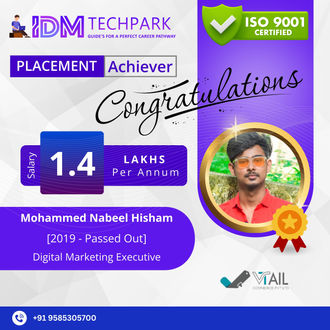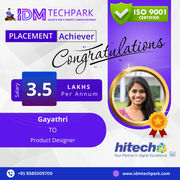Home /React JS Development Training
React JS Development Online Training
Learn to create full-stack web apps with React.js. Join now to learn from a skilled React.js developer.
4.75 out of 5 based on 14525 votes
4.2/5
4.8/5
4.6/5
4.3/5
4.5/5
Course Duration
80 Hrs.
Live Project
2 Project
Training Format
Certification Pass
Guranteed
Live Online /Self-Paced/Classroom
Speciality
500 +
Professionals Trained
20+
Countries & Counting
100+
Corporate Served
React Js Course in Erode
React.js is a fast-evolving JavaScript library developed by Facebook, designed for building dynamic, high-performance user interfaces and single-page applications (SPAs). It emphasizes component-based architecture, enabling developers to create reusable UI components and manage application state efficiently using tools like React Hooks and Context API. React.js enhances developer productivity and application performance through features like the virtual DOM and declarative programming. Integrated with tools such as Redux for state management, React Router for navigation, and build tools like Webpack and Vite, React streamlines the development workflow and enables rapid deployment of scalable front-end solutions. By mastering React, JSX, component lifecycles, and ecosystem tools, developers can build responsive, interactive, and maintainable web applications. With its role in modern web development, React.js is transforming how organizations deliver engaging digital experiences across platforms and devices.

Course includes:
Course Level Expert
Duration: 4 Months
Modules: 47
Certification: Yes
Projects: 5+

Program Core Credentials - React Js Course in Erode
BATCH TIMING
As per your requirement
Training Features of React Js course in Erode
Showcase your Course Completion Certificate to Recruiters
Training Certificate is Govern By 12 Global Associations.
Training Certificate is Powered by "Verifiable Skill Credentials"
Students Placements & Reviews
































2000+ Companies hired

Skills You’ll Learn React Js Course in Erode
This React JS course in coimbatore covers a wide range of skills including:
HTML
REACT JS
CSS
GIT

PYTHON
SPRING BOOT
SQL
JAVA SCRIPT
CORE JAVA
Tools Covered
Some popular Tech Stack you'll have at your fingertips by the end of the React JS Developer Course.
AWS
DOCkER

COMMAND LINE
What are the skills required in React Js course?
Who Can Enroll in the React JS Course in Erode?
There are no strict prerequisites to join the course. However, ideal candidates include:
React JS Development Course Fees & Enrollment
Flexible payment options available.
EMI and installment plans for easy accessibility.
Follow us on Instagram & Telegram for updates on new courses and discounts.
50+ Advanced Modules Covered
- 01
Creating and managing functional and class components
Component lifecycle methods and their applications
Handling events within components
- 02
Managing component state and understanding its significance
Passing data between components using props
Implementing controlled and uncontrolled components
- 03
Setting up routing for single-page applications
Implementing nested routes and navigation
Utilizing route parameters and query strings
- 04
Introduction to Redux principles
Setting up Redux in a React application
Creating actions, reducers, and managing the store
Handling asynchronous actions with middleware like Redux Thunk
- 05
Understanding built-in hooks such as useState, useEffect, and useContext
Developing custom hooks for reusable logic
Best practices for using hooks in functional components

Looking for in-depth syllabus Information ?
Course Highlights and Why React JS Course in Erode at IDM Techpark in Erode?
Comprehensive React.js Training – IDM Techpark offers an in-depth React.js course covering component-based architecture, state management, and virtual DOM concepts.
Industry-Aligned Curriculum – The React.js course is designed by industry experts to provide in-depth knowledge of component-based architecture, state management, and virtual DOM, ensuring proficiency in modern web development.
Regular Recap Sessions – After each class, students receive recap sessions to reinforce key concepts and ensure a strong understanding of full-stack development principles.
Flexible Batch Schedules – IDM Techpark offers flexible training schedules, including weekday, weekend, and fast-track batches, allowing learners to choose the best timing that suits their availability.
Real-Time Project Exposure – The training includes working on live projects to gain practical experience, ensuring that learners are industry-ready with hands-on project development skills.
100% Placement Assistance – IDM Techpark has strong tie-ups with over 3000 companies, providing extensive placement support and career guidance to help students secure high-paying jobs in the industry.
React JS Course Objectives
-
Mastering React.js Fundamentals – Build a strong foundation in JavaScript, ES6+, and JSX to create efficient and scalable web applications.
-
Component-Based Development – Learn to design and structure applications using reusable components, props, and state for dynamic user interfaces.
-
State Management Mastery – Gain expertise in managing application state using React’s built-in hooks, Context API, and Redux for seamless data flow.
-
Routing and Navigation – Implement client-side routing with React Router to create single-page applications (SPAs) with smooth navigation.
-
API Integration & Performance Optimization – Learn how to fetch and manage data from RESTful APIs, optimize rendering, and enhance performance using best practices.
React JS Course Trainer Profile
Industry-Experienced Trainers – Our Full Stack Development trainers are seasoned professionals with expertise in frontend, backend, Angular, React, and other modern technologies.
Comprehensive Student Guidance – With years of experience in mentoring aspiring developers, our trainers provide in-depth guidance to help students master full-stack technologies.
Hands-on Practical Training – Students receive real-time training in both client-side and server-side programming, ensuring a strong foundation in web development.
Industry-Relevant Frameworks – Instructors familiarize students with leading full-stack frameworks, including MEAN Stack, MERN Stack, and other trending technologies.
Regular Progress Assessments – Trainers conduct periodic evaluations and assessments to track each student's learning progress and provide necessary improvements.

Student Success Story of React JS Course in Erode
Rajesh, a passionate tech enthusiast with an MSc in Computer Science, initially started his career in technical support but soon realized his true calling lay in web development. Eager to transition into a more fulfilling role, he explored various upskilling opportunities and discovered the React.js course at IDM Techpark, which aligned perfectly with his career aspirations.
Balancing his job and studies, Rajesh enrolled in weekend classes, dedicating himself to mastering modern web development using React.js. Under the guidance of experienced mentors, he gained hands-on experience in building dynamic user interfaces, managing state efficiently with Redux, and integrating RESTful APIs to develop scalable applications. He also completed multiple capstone projects that showcased his expertise in React.js and frontend development.
After successfully completing the course, Rajesh underwent intensive placement training at IDM Techpark. He then appeared for interviews with top IT firms and secured a Frontend Developer role at a reputed company, earning a competitive salary package. His journey from technical support to a React.js developer stands as an inspiring example of how continuous learning and the right mentorship can unlock new career opportunities in the tech industry.

Have Queries? Talk to our Career Counselor for more Guidance on picking the
right Career for you!
React JS Certification Training in Erode
Upon successfully completing the React.js Course at IDM Techpark, students will receive a certification from the institute, serving as a testament to their expertise in modern web development. This certification validates their proficiency in React.js, component-based architecture, state management, and frontend optimization, ensuring they are well-prepared for industry demands. It enhances their professional credibility and makes them competitive candidates in the job market.
The React.js Course at IDM Techpark is widely recognized by national and international organizations, making it a valuable addition to any resume. This certification demonstrates the student’s ability to build dynamic and responsive web applications using React, strengthening their chances of securing job opportunities in top IT companies. The curriculum is designed to align with industry best practices, focusing on hands-on training with the latest React.js features and tools.
Under expert mentorship, students gain practical experience by developing real-world projects, integrating APIs, and mastering performance optimization techniques. The course is structured to enhance technical problem-solving skills and equip students with the knowledge to build scalable web applications. Earning this certification will significantly elevate career prospects, unlocking new job opportunities in frontend development and React.js-based projects.
Placement Session & Job Opportunities after completing React JS Course in Erode

















Growing Demand for React.js Developers – IDM Techpark, Erode
As businesses continue to shift towards digital transformation, the demand for skilled frontend developers is rapidly increasing. React.js, being one of the most widely used JavaScript libraries for building dynamic and interactive web applications, has become an essential skill in the IT industry. Companies across various sectors, from startups to large enterprises, seek professionals who can develop high-performance, user-friendly interfaces using React.js.
At IDM Techpark, Erode, we are dedicated to providing students with the expertise needed to seize these career opportunities.
“Students will receive 100% placement assistance upon completing the React.js Course at IDM Techpark.”
React.js developers enjoy lucrative salary packages, career stability, and the flexibility to work on freelance projects, expanding their earning potential. Their ability to create scalable and efficient web applications makes them valuable assets in the development industry.
By enrolling in the React.js Course at IDM Techpark, Erode, students will gain hands-on experience, industry-relevant knowledge, and the technical skills required to thrive in the ever-evolving field of web development.



















.avif)

